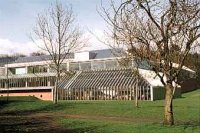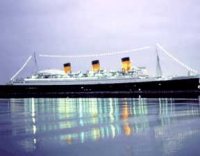The History of Glasgow as a Ship Building City
The Clyde

The River Clyde, from its source in the Lowther Hills to Greenock travels approximately 100 miles and drops 2,000 ft. The City of Glasgow is situated on the river as it starts to widen out as it approaches the sea. The climate is temperate with an average of 40" of rain in a year, and it is not uncommon for the warmest day in the winter to be the same temperature as the coolest day in the summer.
St Kentigern is the patron saint of Glasgow and he established a cathedral there in the 6th century. St Mungo's cathedral still stands today on the same site and is Scotland's best preserved church of the Gothic period. It is largely due to the Cathedral that Glasgow gained its original importance. Glasgow has three universities now, but the original Glasgow University was established in 1451 and is the second oldest university in Scotland.

The Burrell Collection, donated to the City by Sir William Burrell, is housed in a specially designed building in the middle of Pollok Country Park which opened in 1983 and it attracts many visitors to the city to see the treasures amassed by this avid collector.
It is a city of many parks and was the Garden Festival city in 1988. Not much of the garden festival sight remains, but Bell's Bridge, built for the event, is still used. It was also City of Culture in 1990 with events running throughout the year. The building and completion of the Royal Concert Hall was one of Glasgow's main contributions to the Year of Culture.
The city has an underground railway which runs in a circle from the city centre to the south side stopping at Scotland Street School, an example of Charles Rennie Macintosh architecture more of which can be seen round the city. The city is famed for its tenement style of housing which is very different from any equivalent English city, but is a style of living much loved in Glasgow. In 1999 Glasgow will be City of Architecture and Design and there are many fine buildings to be seen round the city, although very few pre-dating the 18th century.
The stretch of the River Clyde between Glasgow and Greenock was naturally very shallow with as little as 2ft draught at low tide. This hampered Glasgow's ambitions as a port in early years, to which end the City Council bought land at Newark Castle and started to build their own port from 1668. This town is now known as Port Glasgow and for a while it was the main customs port for the Clyde. In 1768 deepening of the river was achieved by building a series of dykes to narrow the river channel and thereby increase the flow rate of the river which would in turn increase the scouring effect on the river bed.
However, the main influence on the River Clyde's importance as a shipbuilding centre was the advent of the steam powered ship, from the building of the 'Comet' in Port Glasgow in 1812. The 'Comet' was the first sea going steam ship in Europe and the River Clyde and Glasgow flourished as a steam ship building centre from then up to the First World War. Steam dredgers were used as early as 1824 to clear the bed of the river, but more major work had to be done at Elderslie where a bed of lava ran across the river at a depth of 8ft. This was cleared away by explosives, some 108,000 tons being removed over a period of 53 years.

This enabled some of the biggest ships in the world of their time to be built on the Clyde, e.g. the 'Lusitania' in 1907, the Queen Mary and the Queen Elizabeth, the largest ever passenger liner. From the Second World War ship building world wide has decreased and from being a river lined with ship yards, there are now only a handful left on the Clyde. However, many scale models of ships which were Clyde built can be seen at the Museum of Transport.

